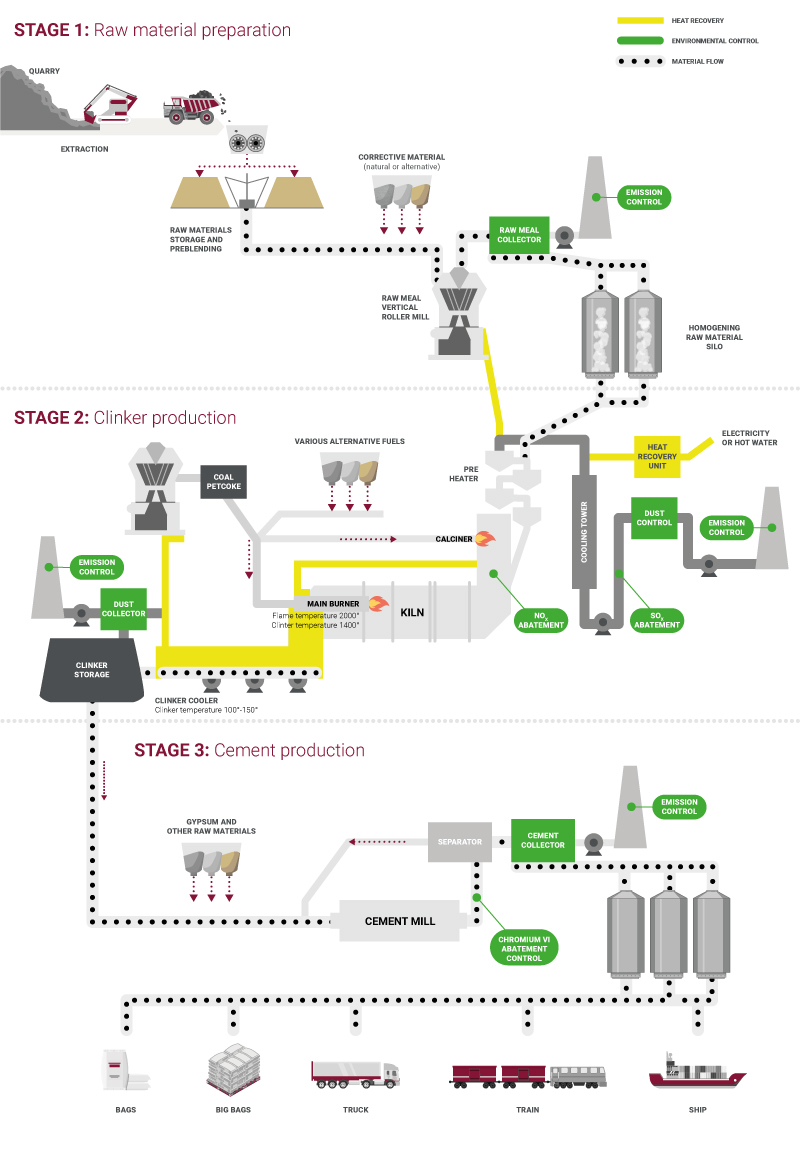Infrastructure, housing and transportation are at the heart of any urban context: cement is part of everything that surrounds us and is one of the most widespread materials on our planet.
Cement is a finely ground mineral powder which reaches solid state through a hydration process when mixed with water, taking a stone-like consistency and maintaining such property over time.Clinker, a fundamental component of cement, is a semi-finished product resulting from burning limestone and other natural minerals at high temperatures.
Cement is classified into types and classes based on the composition of clinker and the presence of other substances (such as blast furnace slag, micro-silica, pozzolan, ash, calcined schist, limestone and secondary constituents) and mechanical resistance to compression and setting times.
Cementir Group produces and distributes all types of grey cement, classified by types according to international standards. As part of continuous research and development effort and with the aim of achieving ambitious sustainability goals, the Group has patented FUTURECEM® a cement with low CO2 emissions which, thanks to special mixtures and ingredients, makes it possible to reduce its clinker content.
All our products follow rigorous industrial processes and Group consolidated best practices in order to guarantee constant quality to our customers over time. Listening to our customers is key for product development and innovation: our technical service constantly supports each customer from design to execution phase of each project.
- Ready-made concrete.
- Prefabricated products: concrete elements produced with industrial processes.
- Pre-mixed products: made with cement, aggregates and other components.
STAGE 1 – RAW MATERIALS PRODUCTION & PREPARATION
Mining or sourcing different raw materials that could be either natural resources (such as limestone, clay, shale, etc..) or alternative resources to produce a suitable dry powder called raw meal composed of defined proportions of Calcium (C), Silica (S), Alumina (A), Iron (F) to feed the kiln.
STAGE 2 – CLINKER PRODUCTION
Heating the raw meal to evaporate water, decarbonate and form the main components of clinker (C3S, C2S, C4AF, C3A)
- Heat is produced by a fuel mix composed of traditional fuels and permitted alternative fuels (a cement kiln is specifically appropriate for alternative fuel usage due to very high combustion temperature, sufficient retention time and ability to capture mineral part in the clinker)
- Before being stored, clinker is cooled down done to secure its hydraulic properties as well as to recuperate energy to feed back in the kiln process
- Heat recovery is maximized for internal use (e.g. drying raw materials or fuels) or external use (e.g. electricity or hot water for local community)
- Gas emissions are controlled on a continuous basis with abatement of relevant components (SO2, NOx, HCl, dust, etc…) whenever necessary.
STAGE 3 – CEMENT PRODUCTION
Mixing and grinding clinker with other raw materials (gypsum, slag, fly ash, pouzzolane, calcined clay, limestone,...) depending on cement types at adequate fineness to reach the desired cement characteristics (strengths, expansion, color...)
QUALITY CONTROL
is done on all input materials & fuels , at every step of the process, on clinker and cement
We offer a wide range of products: grey cement, white cement, aggregates, concrete, value-added products, trading.
We have executed projects all over the world, supporting our customers in all stages of implementation by using cutting-edge technologies.
We are a Group with an Italian soul but a truly international mentality. We have registered offices in the Netherlands and operations in 18 countries.
